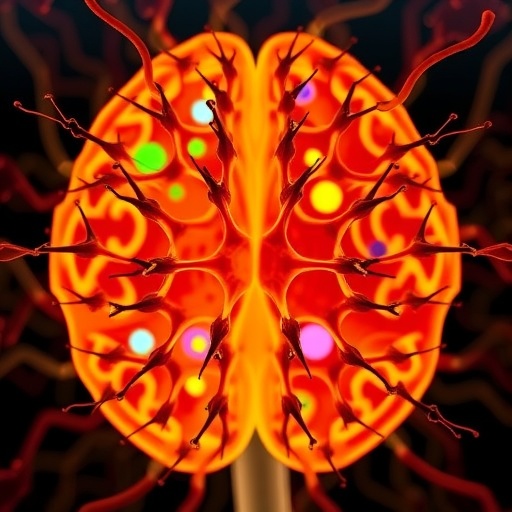In a groundbreaking study published in the Journal of Translational Medicine, researchers led by Khodve and colleagues delve into the intricate world of biomaterials and stem cells, two innovative drivers of neuronal regeneration and modeling diseases in vitro. As the quest for effective treatments for neurodegenerative conditions intensifies, the insights from this research shine a light on potential therapeutic pathways that could revolutionize the field of regenerative medicine.
Neuronal degeneration is a contributing factor in a wide variety of debilitating diseases, including Alzheimer’s and Parkinson’s. The loss of neuronal function can lead to severe cognitive and physical impairments. Traditional approaches to understanding and treating these conditions have often fallen short, calling for novel strategies that blend the latest advancements in biomaterials and stem cell technology. In this research, the authors explore how these two domains can harmoniously interact to promote neuronal health and vitality.
The concept of utilizing biomaterials to support cell growth and function has gained traction over the past decade. Biomaterials can provide a structural scaffold that mimics the extracellular matrix, which is critical for cell attachment, survival, and differentiation. This study emphasizes the use of such materials not merely as passive scaffolding, but as active participants in the regeneration process, potentially fostering a more conducive environment for neural growth and repair.
Stem cells, with their inherent ability to differentiate into diverse cell types, offer extraordinary promise in regenerative medicine. The potential applications of stem cells in treating neurodegenerative diseases stem from their ability to replace damaged neurons, secrete neuroprotective factors, and modulate inflammatory responses. This research meticulously examines various types of stem cells, including embryonic and induced pluripotent stem cells, and their roles in neuronal repair and regeneration.
A significant aspect of the study is its focus on engineered 3D in-vitro models that replicate the complex architecture of the nervous system. Such models are indispensable for understanding the multifaceted nature of neurodegenerative diseases and for evaluating therapeutic strategies in a controlled environment. The researchers highlight how these advanced models can be utilized to observe cell behavior in a three-dimensional context, ultimately improving the predictive power of preclinical studies.
With recent technological advancements, the integration of biomaterials and stem cell therapy in 3D cultures represents a frontier that has the potential to accelerate the translation of research findings into clinical applications. The authors present compelling evidence that these engineered models not only provide a platform for drug screening but also for elucidating the pathophysiology of various neuronal disorders.
Moreover, the study underscores the importance of optimizing biomaterial properties, such as mechanical strength and biochemical cues, to better suit the requirements of neuronal cells. The authors discuss the intricate relationship between cell signaling and material characteristics, positing that a tailored approach to biomaterial design could yield significant benefits in neuronal culture outcomes.
As the study unfolds, it also addresses the critical issue of scalability in creating 3D neuronal models. The authors propose that next-generation bioprinting techniques could facilitate the mass production of these models, paving the way for consistent experimental results across diverse research laboratories. By harnessing the precision of bioprinting, researchers could produce complex tissue architectures that closely mimic the natural environment of the nervous system.
Another exciting avenue explored in this research pertains to the molecular mechanisms employed by stem cells in the repair process. The authors detail how certain growth factors released by stem cells can enhance neuronal survival and function while simultaneously suppressing apoptosis—a process that leads to programmed cell death. Understanding these pathways is crucial for developing targeted therapies that could improve outcomes for patients suffering from neuronal damage.
The study further advocates for collaboration between material scientists, biologists, and clinicians to expedite the translation of laboratory findings into practical treatments. Such multidisciplinary partnerships could create a robust ecosystem for innovation, thereby accelerating the development of regenerative therapies that address unmet medical needs in neurodegenerative diseases.
In summary, the research conducted by Khodve and colleagues provides a compelling narrative around the synergy between biomaterials and stem cells in enhancing neuronal regeneration and modeling diseases in vitro. It encourages a rethinking of traditional therapeutic paradigms and posits that the future of neuroregenerative strategies lies in the integration of advanced materials science with stem cell biology.
As this field continues to evolve, the implications of these findings extend far beyond the realms of basic research; they herald a new era of therapeutic possibilities that could profoundly impact the lives of millions affected by neurological disorders. With persistent efforts and continued exploration of these biological frontiers, we are one step closer to realizing the potential of regenerative therapies that could transform the landscape of medicine.
The exploration conducted by Khodve and his team illuminates both the challenges and opportunities present within the intersection of biomaterials and stem cells. As research efforts advance, it remains essential to maintain a focus on rigorous scientific inquiry and innovation to ultimately bring these promising therapies from the laboratory bench to the clinic.
Subject of Research: Neuronal regeneration and engineered 3D in-vitro disease models using biomaterials and stem cells.
Article Title: Exploration of biomaterial and stem cell-based strategies for promoting neuronal regeneration and creating engineered 3D in-vitro disease models.
Article References:
Khodve, G., Banerjee, S., Kumari, M. et al. Exploration of biomaterial and stem cell-based strategies for promoting neuronal regeneration and creating engineered 3D in-vitro disease models.
J Transl Med 23, 1197 (2025). https://doi.org/10.1186/s12967-025-07266-9
Image Credits: AI Generated
DOI: 10.1186/s12967-025-07266-9
Keywords: Biomaterials, stem cells, neuronal regeneration, 3D in-vitro models, neurodegenerative diseases.
Tags: advancements in translational medicine for neurologyAlzheimer’s disease treatment innovationsbiomaterials in regenerative medicinecell growth support through biomaterialsextracellular matrix mimetics in cell therapyin vitro modeling of neuronal diseasesinnovative approaches to neurodegenerationinteractions between biomaterials and stem cellsneuronal regeneration strategiesParkinson’s disease research advancementsstem cell therapy for neurodegenerative diseasestherapeutic pathways for neuronal health





